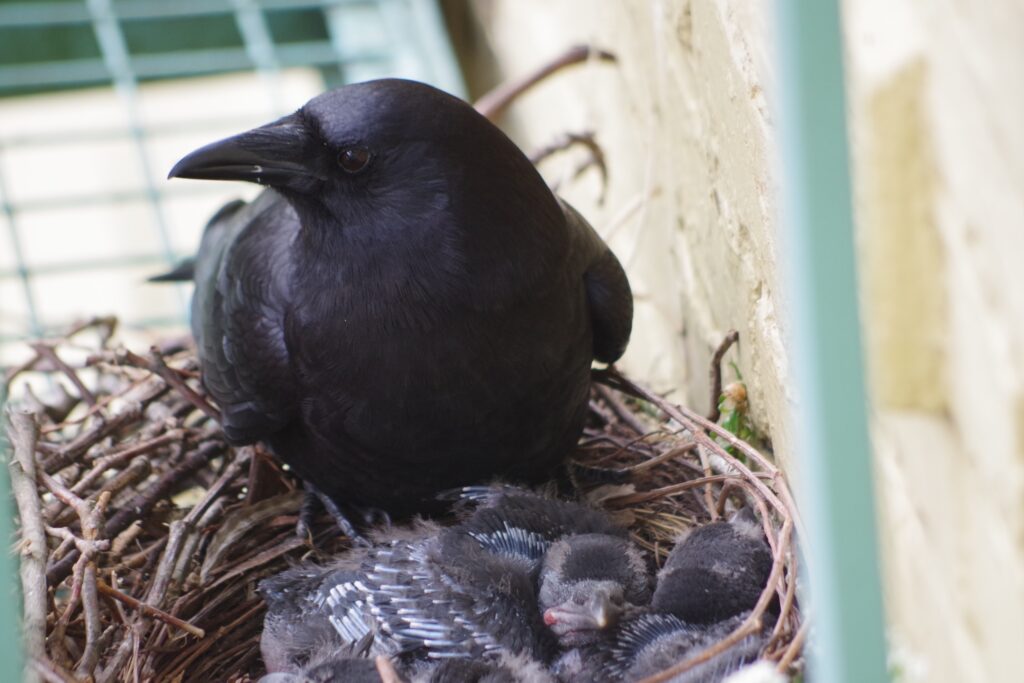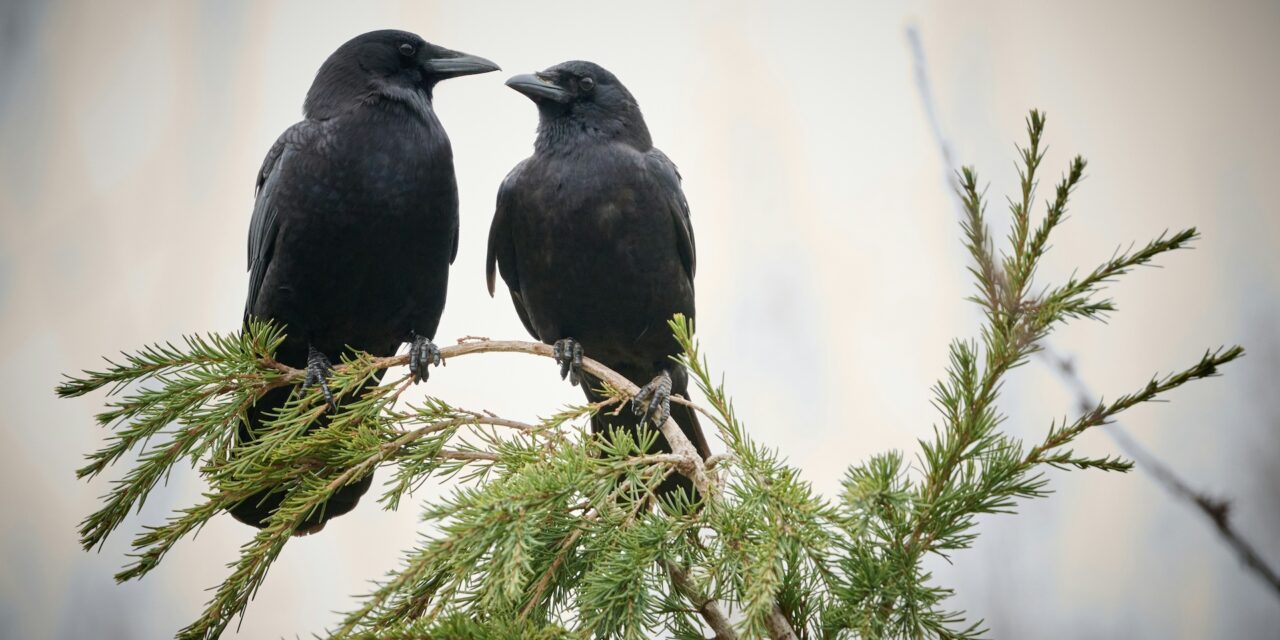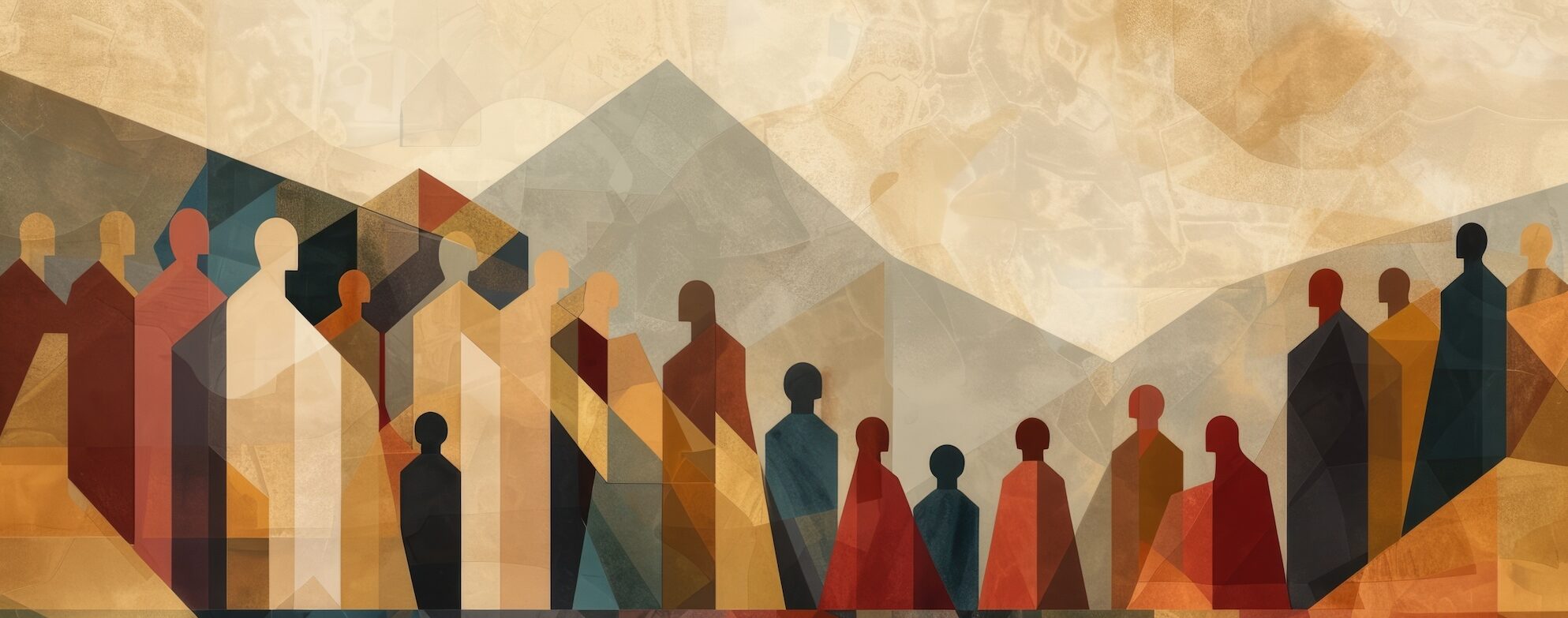One for sorrow,
Two for mirth,
Three for a funeral
And four for birth
English Counting Rhyme, 18th century
In my denomination, before a clergy person is ordained, they are sent on a retreat to prepare for this major life transition: a time of prayer, contemplation, and separation from their usual daily routine. In December 2012, on my pre-ordination retreat, I was caught up in a flock of roosting crows. As I walked alone on a gravel road at dusk, hundreds of crows began to gather on the power lines and rail fences all around me—cawing loudly. With each step I took, the birds ahead of me would rise up and settle back down, wrapping me in a cloud of beating wings that followed me down the road. I felt a great excitement and wonder to be at the centre of so much noise and restless action. It was a kind of stirring joy.
Crows tell me things. I know they are actually communicating with one another, but the cries of a mobbing flock call me to pay attention, to come out and see the one-eyed Barred Owl that has returned to the alley. The alarm calls and fixed directional stare of a lone crow in a willow tree point me to a Mink skulking along the perimeter of Lost Lagoon in Stanley Park. On a grey and cloudy day, a pair of crows, each preening the other’s head and neck feathers, remind me that spring is coming. In June, adult crows’ agitated cries and repeated short dives toward the ground suggest I might want to cross to the other side of the street. Mobbing is a behavior of crows and some other animals where potential prey species collectively harass a predator. Gulls and Fieldfares (a kind of European thrush) will vomit and defecate on a threatening individual with impressive accuracy and volume, while crows usually stick to loud alarm cries and diving attacks with feet or bill.
I am not the only Vancouverite who has encounters with crows. My letter carrier neighbor brings a pouch of chicken livers on her rounds to feed them. She, the teenager in the apartment upstairs, and I all provide snacks for Alastor, the one-legged (well, one-footed, really) courtyard crow named for the battle-scarred Harry Potter character, Alastor Moody. When I give a special whistle, Alastor arrives to eat a row of cat kibble that I line up on the fence, but it’s not a one-way exchange. Alastor has twice given our upstairs neighbor the macabre tribute of a bird’s leg, and then there’s the little girl in Seattle who has an astonishing collection of beads, buttons, paper clips and such delivered by the crows she feeds.

Crows are ubiquitous in the city and have become an icon of East Vancouver life: scrappy, inventive, shabby-chic, and perhaps more than a little cocky. Their silhouettes appear in street mosaics, murals, coffee shop signs, silkscreened T-shirts, and of course, tattoos. For a couple of years, Canuck, an East Van crow—habituated to humans because he was rescued as a fallen fledgling—had a huge social media following, captivating fans with his daytime adventures riding the Skytrain, visiting fast-food outlets, and on one notable occasion, flying off with the knife from a crime-scene. At night, Canuck would leave his human friend and fly east to roost with the other crows.
Towards sunset every night from fall until early spring, small flocks of crows begin to gather all over Vancouver—ten, twenty, thirty, picking up numbers as they make their ragged way east. Fluttering like dark handkerchiefs against the blue sky, they form a cohesive but independent group, flying close together, then spreading apart, some faster than others. Like school children crossing a playing field, clusters form and disperse. Crows fly with a kind of rowing motion and rarely glide. On windy days, they play in the air currents, throwing their bodies against the wind, falling, and catching themselves. Small groups merge and coalesce until an estimated 20,000 of them arrive at a common roost on Still Creek, where East Vancouver meets the City of Burnaby.
In early February I made my first visit to the Still Creek Roost. Following directions from an article online, I arrived at a Costco parking lot about an hour before sunset—too early. There were 30 or 40 birds in bare trees beside the lot and as many again on the ground between the railway ties and beside the tracks. Some bathed in puddles on a flat roof. Farther east, on the power lines and fences outside the city recycling station, were a few dozen more, attracted by the abundance of organics. One on a light post held half a chicken femur, picked clean.
The crows we see in Vancouver are Northwestern Crows, a species that lives along the Pacific coast in sparsely treed areas. Northwestern Crows typically feed in intertidal areas, wading out to catch small fish and marine invertebrates. But they are omnivorous and incredibly adaptive opportunivores, hunting a variety of small animals like amphibians, snakes, and songbirds, and scavenging fruit, grains, carrion, and garbage. They are nest predators who eat the eggs and young of both smaller and larger birds. The Chickadee nesting-box on the cherry tree outside my window is a source of frustration every spring. Crows, who can hear the nestlings but not reach them, take it in turn to stand on the roof of the little house, bending over to insert their bills through the quarter-sized opening. Crows will steal food from humans, Bald Eagles, gulls, and other crows, and in times of abundance, like low tide, they cache food, hiding it for later. My friend Ron regularly sees a crow that drops clams in front of passing cars then dives down to eat when the road is clear.
I found myself noticing the traits of individual crows: one was missing a primary feather, another sported puffy head feathers like the drummer from an 80s hair band, that one had an over-long upper bill. After about half an hour, there were still only about 100 birds. As the numbers stayed static, I wondered, “Are they really coming? Maybe they’ve chosen a different place to roost tonight. Maybe this is it.”
As the light dimmed, more crows silently appeared: in the trees in the parking lot, on fences, perched on the handle of a shopping cart. I saw very few in the air. It was as though they materialized when my back was turned.
My perception, from years in Vancouver, was that the crows fly east to roost, so I scanned the skies to the west and climbed a concrete staircase to the overpass for a better view of the city. And they came in intermittent groups of 20 and 30. Then, as I looked behind me across the roof of Costco, across the lot where city-owned vehicles are parked, I could see a flickering cloud in the distance—moving and billowing, drifting left and right, separating, re-forming and slowly becoming more distinct. Finally, the glittering specks resolved into hundreds of birds flying west. And, unlike the silent specters already in the trees, they called to one another constantly.
I moved closer as wave after wave kept coming from the east. While there was not a ceaseless flow of birds overhead, for about an hour there was no point at which there were not crows in the air.

Standing beneath the waves, looking up at the silhouettes moving overhead, I was overwhelmed by their numbers. Suddenly, I was swept with a feeling of certainty that, whatever happens to humans in this global ecological crisis, however the excesses of the few are suffered by the impoverished many, whatever number of species and habitats we take with us as our own numbers are decimated or extinguished, life—the energy, drive, and beauty embodied in these crows (whether Northwestern Crows as a species continue or not) cannot be stayed. And that in the face of that unstoppable life-force, humans, and this human in particular, are not very important. Perhaps that is not a very comforting sentiment, but I found myself profoundly reassured; it shifted my perspective towards evolutionary time. And in that shift, that reassurance, I heard the Divine voice.
Intelligent, social, and starkly coloured, corvids feature in various religious traditions around the world. Huginn and Muninn are ravens who carry information to the Norse god Odin. In Japanese Buddhism and folk practice, Crow Tengu are disruptive spirits depicted with crow heads on human torsos. In China, Korea and Japan a three-legged crow is a deity or messenger who lives in the sun. The biblical prophet Elijah is fed by ravens. On the Pacific coast, in several Indigenous traditions, Raven is a powerful trickster. In the Qur’an, a crow triggers the remorse of Cain, the first murderer, by showing him how to bury his brother.
Crows have been congregating near Still Creek since the 1970s. In winter, the roost is at its peak size, with adults and hatch-year birds together. In 2019 a frequently quoted news article estimated there were 20,000 individuals; my sources say about 15,000, although other observers claim fewer still. Roosting in the thousands is a recent phenomenon that seems to be a response to a combination of factors: habitat loss, access to urban food sources, and the defenses against predators provided by city lights and critical mass. Crows are one of the species that urban ornithologists call “exploiters”; their ability to adapt to and thrive in conditions created by humans has increased their reproductive success.
My powerful sense that crows, and indeed life itself, will carry on however humans trash this planet, puts me in mind of certain biblical passages. Scattered throughout the oracles of prophets and the lyrics of psalmists are warnings of the woe and desolation that await those whose faithfulness is lacking. The fate of those who demonstrate their lack of faith by failing to care for vulnerable members of society, neglecting the minutiae of prescribed worship practice, or whoring after alien gods, is occupation: ravens, jackals, thorns, and owls will occupy their cities.
The creatures that the prophets name are the “exploiters.” They are scavengers and co-existers. Liminal like crows, Coyotes, and Himalayan Blackberry, they are the ones who will expand to fill the vacant niche when we humans have self-destructed. Biblically, the night creatures’ and carrion eaters’ occupation of the city is intended to demonstrate how the wicked will be annihilated, but it gives me a subversive kind of hope. It is an inadvertent testament to the resilience of creation; whatever humans do, these scripture passages proclaim, the more-than-human world will inevitably reassert itself—if there are corpses in the street, for a while at least, the crows will do well.
I love many things about crows: their shiny feathers, the wealth of detail and subtlety in the colour black, and their seeming sameness but the remarkable difference between individuals. They are confident, inquisitive, hilarious; I once saw a crow on a playground hide a stolen Oreo under a pile of leaves. I love their interactions with one another, with humans, with other species. They are extremely relatable and at the same time quite alien. Perhaps what I love most of all is that they are so ordinary—I see crows every day, and the crow roost, this miracle of the assembling thousands, is completely accessible. They are not shy or “exotic”; you do not require special equipment to see them or have to travel any distance; no years of meditation techniques, no religious functionary’s mediation are needed. Ride a bus to a box store parking lot for straight-up access to the Divine in the heart of the city.
This chapter is an excerpt from Laurel Dykstra’s book, Wildlife Congregations, which has just won a City of Burnaby Environmental Award for Communications. It is published by Hancock House, the premier nature publishing house in Western Canada, and reprinted here with permission.
Cover photo credit: Steve Smith
All other photos: Laurel Dykstra


